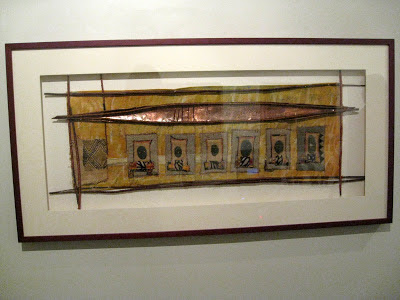
My 1st visit to the Royal Ontario Museum was a most interesting experience.
I got totally engrossed in artifacts displayed in the more traditional vitrines.
(above - woman's 'apron', Brazil)

In the newest area of the museum there are more contemporary display methods.
(Above - early 18th century silk on silk embroidery made to be an apron).

New display methods allow for satisfyingly close inspection of artifacts.
(Gilt and silver threads worked with silk threads).

Supporting images and artifacts cut down on the need for much text and help to place the artifact in context.
(Painting of early 18th century English drawing room where the women wore the heavily embroidered aprons).
However, the enjoyable viewing experience was deflated every time I had to move to another display area within architect Daniel Libeskind's 5 interlocking crystal forms built between 2 older wings of the museum. I found no natural flow from one area to another but I did find many dead ends. The architect's ego seems to have got in the way of meeting human needs within a space.

Yes, that door is on a disturbing angle.
Random lines on the floor appear and disappear making the walls feel insubstantial and temporary.

No, the left door can't be fully opened.
Acute angles are dust traps the cleaners' machines obviously can't get into.
People repeatedly kick unexpected wall protrusions and knock their heads on acutely angled walls then put their hands out for protection. The whole place is building up the patina of a well used obstacle course.
If large mirrors were added to the walls it could possibly be more successful as a fair-ground type, mirrored, fun house maze. Ooops, that's a bit harsh.
Actually, there was one display area where I felt the jarring, discordant spaced worked. It was the most serious and emotionally intense exhibition - photographs of victims tortured by the Khmer Rouge regime in Cambodia between 1975 and 1979, Observance and Memorial, Photographs From S-21, Cambodia. www.rom.on.ca/cambodia
Check this link and look at the images on the right hand side. The 2nd to bottom one, where the book is open for people to sign. I hit my head while trying to get in a line to sign the book - awkward!








































